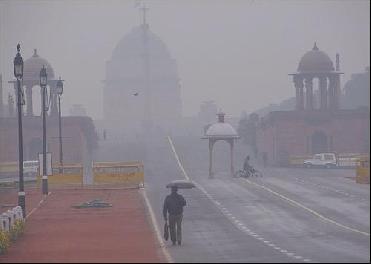
Smog cover Delhi's Rajpath. File photo
NEW YORK (PTI): Asian cities from New Delhi to Beijing are getting darker, glaciers on the mighty Himalayas are melting faster and weather system is becoming more extreme, a United Nations study has warned.
This alarming phenomenon has also spread its dragnet to other cities like Mumbai, Kolkata, Bangkok, Tehran, Cairo, Seoul, Karachi, Dhaka and Shanghai.
What common citizens perceived for long as an early onset of winter, is not so.
Due to the burning of fossil fuels and biomass, the Atmospheric Brown Clouds (ABCs), made of soot and other man-made particles, are more than three km-thick, according to the study.
The report, compiled by the UN Environment Programme (UNEP), said the dimming is as much as between 10 and 25 per cent over cities like New Delhi, Karachi, Beijing and Shanghai.
But the worst-hit appears to be the Chinese city of Guangzhou, where sunlight in winter had dimmed by more than 20 per cent since the 1970s.
For India as a whole, the dimming trend has been running at about two per cent per decade between 1960 and 2000 -- more than doubling between 1980 and 2004. In China, the observed dimming trend from 1950s to 1990s was about 3 to 4 per cent per decade, with the larger trends noticed after the 70s, as per the report.
The study, conducted by a team drawn from research centres in Asia, including India and China, Europe and the US, announced its latest and most detailed assessment of the phenomenon.
The brown clouds, the toxic result of burning of fossil fuels and biomass, are in some cases and regions aggravating the impacts of greenhouse gas-induced climate change phenomenon. This is because ABCs lead to the formation of particles like black carbon and soot that absorb sunlight and heat the air; and gases such as ozone enhance the greenhouse effect of carbon dioxide.
Globally, however, brown clouds may be countering or “masking” the warming impacts of climate change by between 20 and 80 per cent, the researchers suggest. The cloud is also affecting air quality and agriculture in Asia besides posing threat to human health and food production for three billion people.
Achim Steiner, Under-Secretary General and Executive Director, UNEP, said, "I expect the Atmospheric Brown Cloud to be now firmly on the international community's radar as a result of today's report."
The five regional hotspots for ABCs identified in the report include the Indo-Gangetic plains in South Asia from the northwest and northeast regions of eastern Pakistan across India to Bangladesh and Myanmar, the UNEP said in a statement. The report said New Delhi, Kolkata and Mumbai feature in the list of 13 mega cities where ABCs are reducing the sunlight hitting the Earth's surface, making the cities “darker or dimmer”.
 Previous Article
Previous Article Next Article
Next Article













The Indian Air Force, in its flight trials evaluation report submitted before the Defence Ministry l..
view articleAn insight into the Medium Multi-Role Combat Aircraft competition...
view articleSky enthusiasts can now spot the International Space Station (ISS) commanded by Indian-American astr..
view article